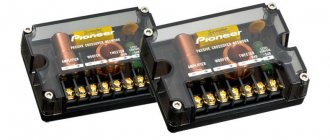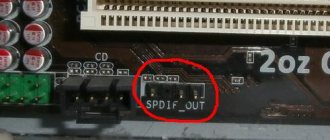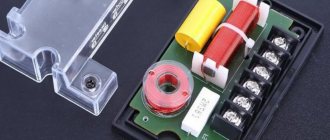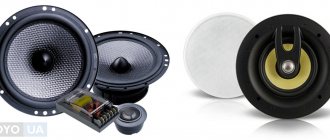Every modern speaker is quite limited in its capabilities, as it is not able to reproduce the entire spectrum of sound frequencies. Its effective operation is determined by a certain range of reproduced frequencies, and the width of this range is quite small. Frequency limitations are related to the resonant frequency of the moving system of its design (upper limit) and the mechanical properties of the diffuser, such as mass and stiffness (lower limit). Sound outside the frequency range of the speaker is distorted or the sound pressure is significantly reduced. Let us recall that the human ear perceives sound signals with a frequency of 20 -20,000 Hz, this is a fairly wide range and it is certainly wider than the range that any speaker can produce. There is a solution: use several speakers! Brilliant, right? All that remains is to divide the entire range of the sound signal into ranges for individual speakers included in the speaker system. And sound crossovers help us with this.
What is audio crossover? This is a built-in or separate device designed to separate sound into frequency ranges for certain types of speakers. This is a kind of filter that cuts off unnecessary frequencies, passing only a certain range. The fact is that the design of the speakers requires them to operate at a certain frequency, otherwise the sound picture will deteriorate, or the speakers may simply fail. For example, a tweeter is designed to reproduce high frequencies and supplying a low frequency signal, and even high power, can lead to the speaker simply “burning out”. Therefore, we follow a simple rule: we apply high frequencies to high-frequency speakers, low frequencies to low-frequency speakers, and medium frequencies to mid-woofers. It's simple, isn't it? All that remains is to divide the input signal into the appropriate frequency ranges. This is what a crossover does.
A crossover is a pair of electrical filters that cut off “extra” frequencies. Therefore, the main characteristic of the filter is the cutoff frequency - this is the minimum frequency of the transmitted signal; frequencies below will be cut off by the filter. For example, a two-way crossover cutoff frequency of 1000 Hz means that one crossover filter (high-pass filter) passes only frequencies above 1000 Hz and cuts off the rest; the other filter (low-pass), on the contrary, passes frequencies below 1000 Hz, cutting off high ones. Three-way crossovers also have a mid-frequency filter (band-pass), which passes only the middle frequency range.
On a graph, crossover cutoff frequencies can be defined as the points at which two or three curves intersect.
Crossover is...
I didn’t expect that this word has so many meanings – crossover. Here are some concepts.
- This is an organism or some kind of DNA molecule. Something to do with DNA science...
- In sports, it is a machine for strength training. A huge power machine for bodybuilding.
- This is the point of minimum cross section of the electron beam in an electron microscope. I never even thought about this...
- The type of car is a well-known concept. An intermediate option between a simple passenger car and an SUV.
- Crossover is music in which several different styles are mixed.
- This concept also exists in computer technology. This is the name of the wire for directly connecting the network cards of two computers.
- Audio crossover filter (for example, a filter for a multi-band speaker system). This is our option!
Prologue, very short.
We sit at home, listen to music, enjoy. Then, a little time passes, and very often we begin to think about technical issues. How do you get sound from speakers? How and with what is it processed from a disk or flash drive? Why do some speakers play beautifully, while others sound like a plastic box? What is in the speakers, besides beautiful speakers - some kind of wiring on coils, tubes and all sorts of incomprehensible things, what are they there for?
In any case, the owners of acoustics, not from a music center, know what speakers are and what they are. Also, they already understand which speaker plays which frequency and what it is called, for example - tweeter, midwoofer, midbass.
And in addition to the speakers, there is always a filter installed in the acoustics, which is capable of dividing the entire frequency spectrum into two or three parts and directing the desired part to the corresponding speaker. This is just a crossover.
What are acoustic crossovers? Let's try to clarify this question a little - what is in our home acoustic systems (speakers), what is a crossover?
Where is it placed?
Considering that the crossover cannot be installed in any place, it is worth noting those places that are suitable for installing speakers and amplifiers.
Requirements for installation sites:
- Absence of any leaks or dampness;
- Free and comfortable access for both connection and configuration;
- Excellent air circulation for cooling;
- The absence of any inconvenience or interference that is in any way related to the operation of the vehicle;
- Good visual appearance.
Most often these are places such as:
- Seat backs (rear);
- Rear shelf (the compressor can be located either below or above);
- Under the seats (front);
- Under the trunk floor (if the vehicle design allows this.
Crossover filter
Let's start in order. As Wiki suggests, a crossover is essentially a filter. Filter is a device for selecting the desired components of the spectrum of an electrical signal and suppressing unwanted frequencies. How it is formulated is not clear. Let's try differently.
Crossover in speaker systems are devices that create certain boundaries of frequency ranges for speakers. Almost all speakers are designed specifically to operate within a specific frequency range.
For example, low-frequency speakers can play from 10 to 2500 Hz, but you may not get high-quality sound at frequencies of 1000-1500. There are other speakers for this – mid-range ones. They can already play from 200 to 8000 Hz, but at the maximum frequencies there will definitely be distortion. The highest frequencies can easily be handled by high-frequency speakers, whose range can be from 2000 to 20,000 Hz and higher.
All speakers really don’t like to play “foreign” frequencies. This does not apply to wideband speakers, the situation is different there.
If you apply a low frequency to a high-frequency speaker (those who know it call it a “tweeter”), the sound picture will be simply terrible. And if it plays long enough and at high power, the tweeter will simply “burn out” (otherwise, it will break and stop working). Tweeters should only handle high frequencies.
In turn, woofers should play only the low-frequency range. The remaining middle band will be correctly reproduced by mid-frequency speakers (they are also called midwoofers).
Here we will make a preliminary conclusion.
The purpose of crossovers is to divide the audio signal into the desired frequency ranges for the appropriate types of speakers. That's all science! But in reality, that's not all.
Advantages and disadvantages
Active crossovers
Pros:
- Convenience during operation;
- The switches are output directly to the housing.
Minuses:
- Too expensive;
- The need for active crossovers in amplifiers for channels;
- The presence of distortions in the work that arise due to the operation of the elements of these devices.
Passive crossovers
Pros:
- Dividing signals into systems with several bands, and this requires only two amplification channels;
- Low cost.
Minuses:
- Impossibility of configuration without direct intervention in the entire electricity supply circuit;
- Select according to the acoustic system bands used;
- Configuration, selection and installation are processes that require professional knowledge and experience.
How does a crossover work?
Let's look at the picture (taken from the Internet - everything is shown very clearly).
The diagram approximately shows the operation of three filters, which are configured for frequency cuts - 500 Hz and 4500 Hz. Such a crossover is needed for three-way acoustics. Let's briefly try to describe what is shown here.
The first filter is a low pass filter (LPF), set to a frequency of 500 Hz. This means that the filter passes frequencies up to 500Hz, and simply cuts off the rest, preventing them from reaching the subwoofer (let’s call it the red corridor).
The second filter is a mid-pass filter (MSF - Band Pass), it cuts off all frequencies up to 500 Hz and everything after 4500 Hz. In other words, the filter does not allow frequencies below 500 Hz to reach the midrange speaker. Also, the filter does not allow high frequencies from 4500 Hz to reach the speaker. (let's call it the blue corridor).
The third filter is a high-pass filter (HPF - Hi Pass). It only passes frequencies above 4500 Hz to the tweeter. (green corridor).
Settings Features
In order to get high-quality car audio as a result, you need to choose the right cutoff frequency. When using an active three-way crossover, two cutoff frequencies must be determined. The first point will mark the line between low and medium frequencies, the second - the line between medium and high. Before connecting a crossover, the car owner must always remember that it is necessary to correctly select the frequency characteristics of the speaker.
In no case should you apply frequencies to them at which they simply cannot operate normally. Otherwise, this will not only lead to deterioration in sound quality, but also to a reduction in service life.
Passive crossover connection diagram
Filter order
This concept is an integral part of the crossover, but it is not entirely easy to understand. What does this mean? In purely scientific terms, this is the ratio of the intensity of the output signal (dB) of the crossover to the frequency of the input signal, provided that the intensity of the input signal is constant. The filter order or direct sensitivity depends on the steepness of the cutoff. Typically, sensitivity (slope) is characterized as a ratio (decibel/octave - dB/octave).
In the picture above, in the form of colored lines that are not located horizontally, at a certain, different angle, the slope of the cut is shown in the ratio of intensity (dB) to frequency (Hz).
Purely mathematically, the sensitivity of crossovers is always a multiple of 6 decibels per octave (6 dB/octave).
Audio systems use crossovers, which are divided into four orders of filters.
- a first-order crossover has a sensitivity of 6 decibels per octave;
- second order – 12 decibels per octave;
- third order - 18 decibels per octave;
- fourth order - 24 decibels per octave.
Let's understand filter orders
Consider a low-pass filter (low-pass), as a third-order filter , with a cutoff frequency of 100 Hz.
We already understand that a filter set to a frequency of 100 Hz will only pass through frequencies below 100 Hz, and will “cut out” all frequencies above 100 Hz from the sound spectrum. In other words, all frequencies above 100 Hz will be attenuated by a multiple of 18 dB, depending on the octave they belong to, since this is a third-order filter.
Let's say a frequency of 200 Hz is the first octave, above the cutoff frequency, it will be attenuated by 18 dB. And the intensity of the frequency 400 Hz - this is the second octave, will already drop by 36 dB. The third octave of 800 Hz will already lose its activity by 54 dB. And so on. All subsequent octaves will be attenuated by a multiple of 18 dB.
A low-pass filter, like a first-order filter with the same cutoff frequency - 100 Hz, will be less sensitive. It will do the same thing as a third order filter (18 dB per octave), but the octaves there will be attenuated by only 6 dB.
Order of filters in pictures
To put it simply, the pictures will make it clearer and more visual how filters “cut off” frequencies. For example, a filter with a cutoff frequency of 2000 Hz.
The first order filter reduces the intensity of each octave by 6 dB. The ups and downs are smooth. They have a large frequency coverage both to the left and to the right of the main cutoff frequency. The speakers will be able to play not only “their” range, but also “someone else’s”, which will be at a lower intensity level. The advantage of this filter is that there is no phase shift between the tweeter and the other speaker. We’ll look at what a “phase shift” is in another article – here.
The second order filter reduces the intensity of each octave by 12 dB. The ups and downs are much steeper. But the speakers will play both “their” and “foreign” frequencies in a narrower frequency range. But there is a minus - the filter gives a phase shift of 180 degrees. This means that there will be asynchronous movement of the membranes of the tweeter and the other speaker (in different directions). To avoid this, you need to change the polarity of the wires on the tweeter.
A third-order filter reduces the intensity of each octave by 18 dB. The cuts here are very steep. Such cuts have good phase characteristics for any speaker polarity. But there is a significant drawback. Problems arise with speakers emitting sound in different vertical planes. In this case, it will not be possible to use time delays to correct such problems.
Fourth order filter - allows you to lower each octave by 24 dB. The cuts are almost vertical. This allows the coupling of the speakers in the frequency separation area to be dramatically reduced. The phase shift is 360 degrees. This means virtually no shift. But the phase shift itself here has a non-constant component, which often leads to unstable operation of the filter. They try not to use fourth-order crossover in practice. But it is not all that bad.
Fourth order filter optimization.
In 1978, engineers Siegfried Linkwitz and Russ Riley managed to optimize the design of a fourth-order crossover. An electronic filter with an infinite impulse response was named after them - the Linkwitz-Riley filter.
This crossover consists of two second-order Butterworth crossovers connected in series for the tweeter, and the same for the woofer. Their sensitivity is also 24 dB per octave, but the output level of each filter is 6 dB less than the crossover output level.
The Linkwitz-Riley filter has no phase shifts and allows time correction for speakers that do not operate in the same physical (vertical) plane. These crossovers provide the best acoustic performance compared to other designs.
Epilogue
It's not easy to understand these concepts. To be honest, for an ordinary fan who just listens to music, this doesn’t mean anything special. Of course, almost any music lover has heard, and probably knows, about the presence of crossovers in his speakers. But not everyone will delve into the subtleties and nuances. He plays - both well and well!
Judging by the information received from sites where people make these same crossover filters, this task is not an easy one. It seems that there is nothing complicated. But each speaker has its own characteristics and a “standard” crossover will probably not suit your acoustics. Therefore, this whole activity - the manufacture of crossovers - moves into the category of engineering developments.
Crossover calculations
I believe that calculations, selection of components and assembly of crossovers is a job for professionals. There are not so few of them, but they are not often found on the street, or through an advertisement on the Internet or in a newspaper. They begin to look for them when all options for improving their musical complex (specially selected sound-reproducing equipment) have almost been exhausted.
Some, simply, simply, ran out of money that they could spend on improving and improving their musical equipment, and they stopped there. But the idea still does not leave them - “improve!” They begin to study how they can improve sound without huge investments. And in the end, they come to the conclusion that something is wrong with their speakers: “A friend has almost the same equipment - he has the sound, but I don’t. What's the matter?"
Others simply decided that they were almost there. Expensive equipment is installed at home, the amplifier weighs about twenty kilograms, the vinyl player was not bought “for a hat of crackers,” the records did not cost 50 rubles, and the acoustics, it seems, are not the simplest. But something tells them that they can still change and improve something. But how? They start trying to change amplifiers, and then acoustics. But they don’t get the desired result.
From practice..
As practice shows, factory-made acoustics, with crossovers designed for these speakers, sound, but may sound better. Of course, you won't be able to achieve perfection. The limit of perfection is different for everyone, as is hearing and perception of sounds. But you can get changes in the sound of your own acoustics. This is not always justified due to the cost of acoustics.
It is possible and necessary to improve the old S-90. So many experiments have already been carried out on this matter! The costs will not be that large, but the effect can be very significant. You can even modify the S-30, and they will delight you with a new sound. It makes sense to upgrade the home theater acoustics, which are not expensive, but can sometimes impress with their sound effects when watching a movie.
But does it make sense to modify speakers that cost four hundred thousand rubles? Expensive acoustics are developed at the factory very carefully and the components are selected not from a table, but based on the actual measurements of the speakers. In short, in such speakers, the crossovers, one might say, are ideally adjusted to the volume of the speakers, to specific speakers. And therefore, such speakers can play one hundred percent. But this is not always the case. You can modify the crossovers in such acoustics.
Active and passive
Another classification is passive and active. The main difference between these two types is the components from which they are composed.
Active ones consist of components that require constant operation of power sources. These are, for example, microcontrollers, amplifiers and other elements.
As for passive ones, they are created from elements that do not require power, for example, coils, as well as capacitors and resistors.
Another difference is that active ones can only be mounted in front of the amplifier, while passive ones have more choice - they can be mounted in front of the speaker itself.











